Abstract
1. The activity of CDP840, a novel, potent and selective cyclic nucleotide phosphodiesterase type 4 (PDE 4) inhibitor, was evaluated in guinea-pig models (in vitro and in vivo) of bronchospasm, ozone-induced airway hyperresponsiveness (AHR) and non-cholinergic bronchoconstriction. Comparisons were made with (i) other PDE 4 inhibitors: CT1731 (S-enantiomer of CDP840), rolipram, RP73401 and (ii) the clinically used agents salbutamol and theophylline. 2. CDP840 relaxed isolated trachea, under basal tone (EC50 4.5 +/- 1.1 microM) being 17 fold less potent than rolipram (EC50 0.26 +/- 0.13 microM) but attaining the same Emax (83 +/- 6% of the response to 300 microM papaverine). 3. CDP840 relaxed tracheae pre-contracted with carbachol (IC25 39 +/- 9 microM) and histamine (IC25 4 +/- 1 microM) producing monophasic curves. Stereoselectivity was not observed with CT1731 against either carbachol (IC25 33 +/- 11 microM) or histamine (IC25 17 +/- 10 microM). Aminophylline was 1.6 fold (carbachol) and 11 fold (histamine) less potent than CDP840. Rolipram and RP73401 produced tri-phasic relaxation curves but were of similar potency (at the IC25 level) to CDP840 against carbachol (rolipram 18 +/- 5 microM, RP73401 39 +/- 1 microM) whereas against histamine they were approximately 20 fold more potent (rolipram 0.2 +/- 0.1 microM, RP73401 0.2 +/- 0.1 microM). In producing > 30% (carbachol) and > 60% (histamine) relaxation these inhibitors had similar potency and were poor compared to salbutamol. 4. Pre-incubation with CDP840 (10 microM) did not antagonize histamine-induced contraction of isolated trachea; however, it did cause a slight potentiation of the subsequent relaxation to salbutamol (IC50 23 +/- 1 to 15 +/- 2 nM). 5. Pretreatment (1 h) with either CDP840 (1 mg kg-1, i.p. or 3 mg kg-1, i.v.) or rolipram (1 mg kg-1, i.p.) did not bronchodilate or antagonize bronchospasm due to inhaled histamine in anaesthetized, ventilated guinea-pigs. Salbutamol (1 mg kg-1, i.p.) did not bronchodilate but caused a parallel 7 fold rightward shift in the histamine dose-response curve. 6. Stimulation of the vagus nerve in the presence of atropine resulted in a frequency-related bronchoconstriction. CDP840 and rolipram (i.v.) inhibited the response being approximately equipotent (EC50 approximately 10 micrograms kg-1). Neither drug inhibited bronchospasm to inhaled substance P. 7. CDP840 (1-10 micrograms kg-1 i.p.) dose relatedly inhibited ozone-induced bronchoconstriction. CT1731 (1 mg kg-1), rolipram (1 mg kg-1), RP73401 (10 micrograms kg-1) and aminophylline (10 mg kg-1) had no effect. Ozone-induced AHR to inhaled histamine was inhibited by CDP840 in a dose-related manner, 10 micrograms kg-1 abolishing the AHR. This effect was stereoselective as CT1731 was approximately 30 fold less potent than CDP840. Rolipram was approximately 100 fold less potent and RP73401 and aminophylline had no effect. CDP840 was orally active being approximately 10 fold less potent compared to i.p. administration. 8. CDP840 is a poor spasmolytic and anti-spasmogenic agent in response to exogenous mediators; however, it potently inhibits vagally mediated non-cholinergic bronchoconstriction and ozone-induced AHR to histamine. It is possible that regulation of cyclic AMP by PDE 4 contributes to neuronal sensitivity in the airways. Furthermore, CDP840 may suppress AHR without being an overt bronchodilator. Such a profile of activity may have therapeutic benefit in airways diseases such as asthma.
Full text
PDF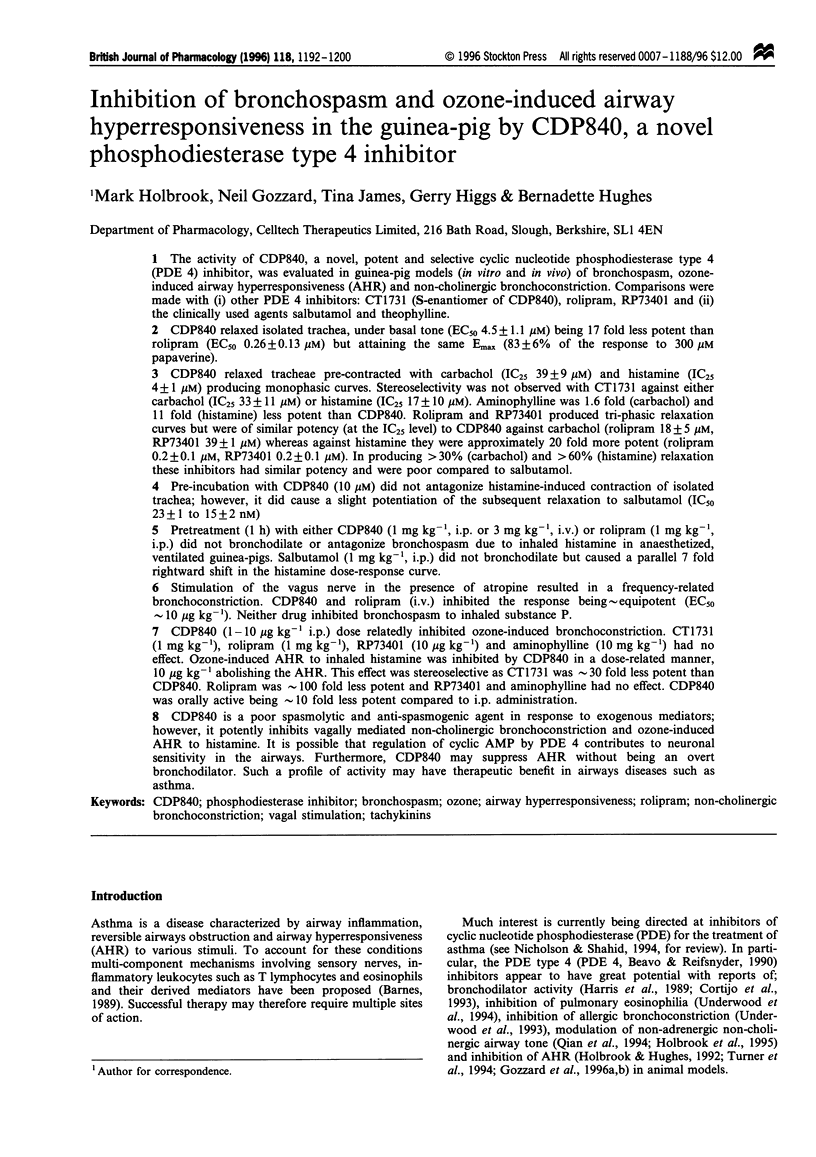
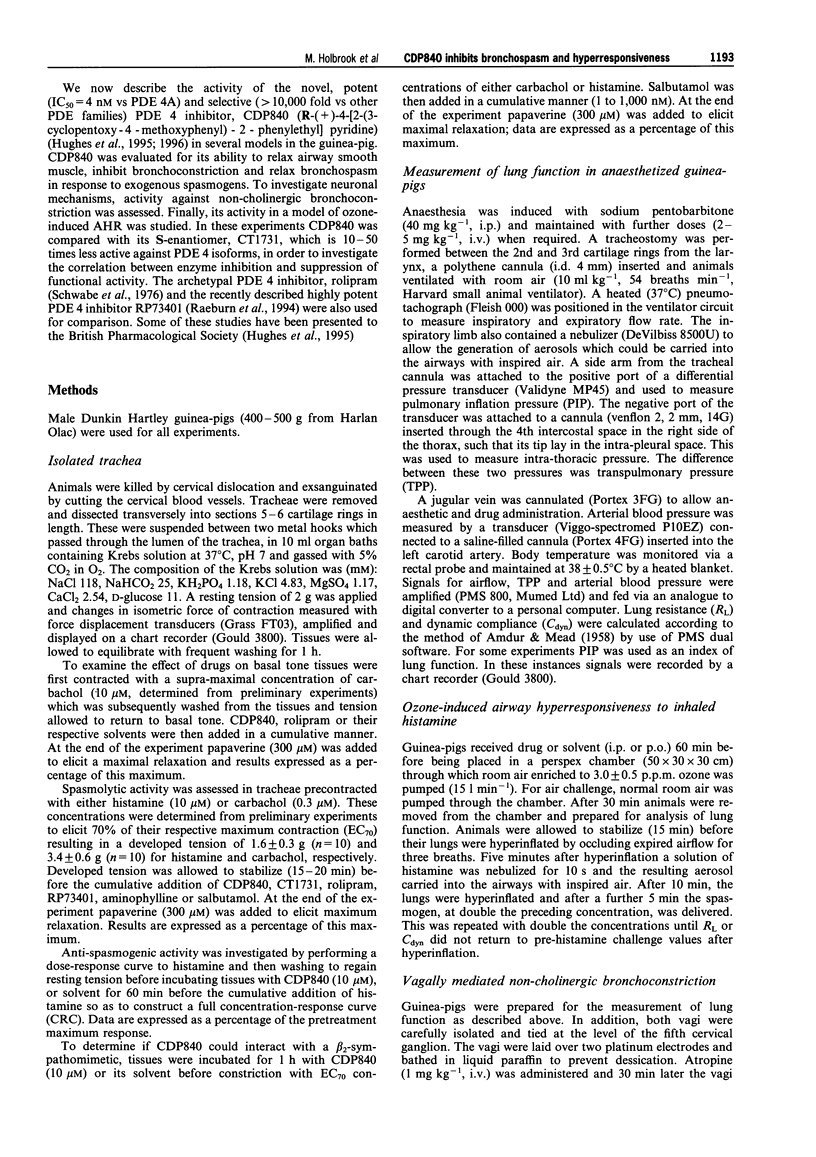
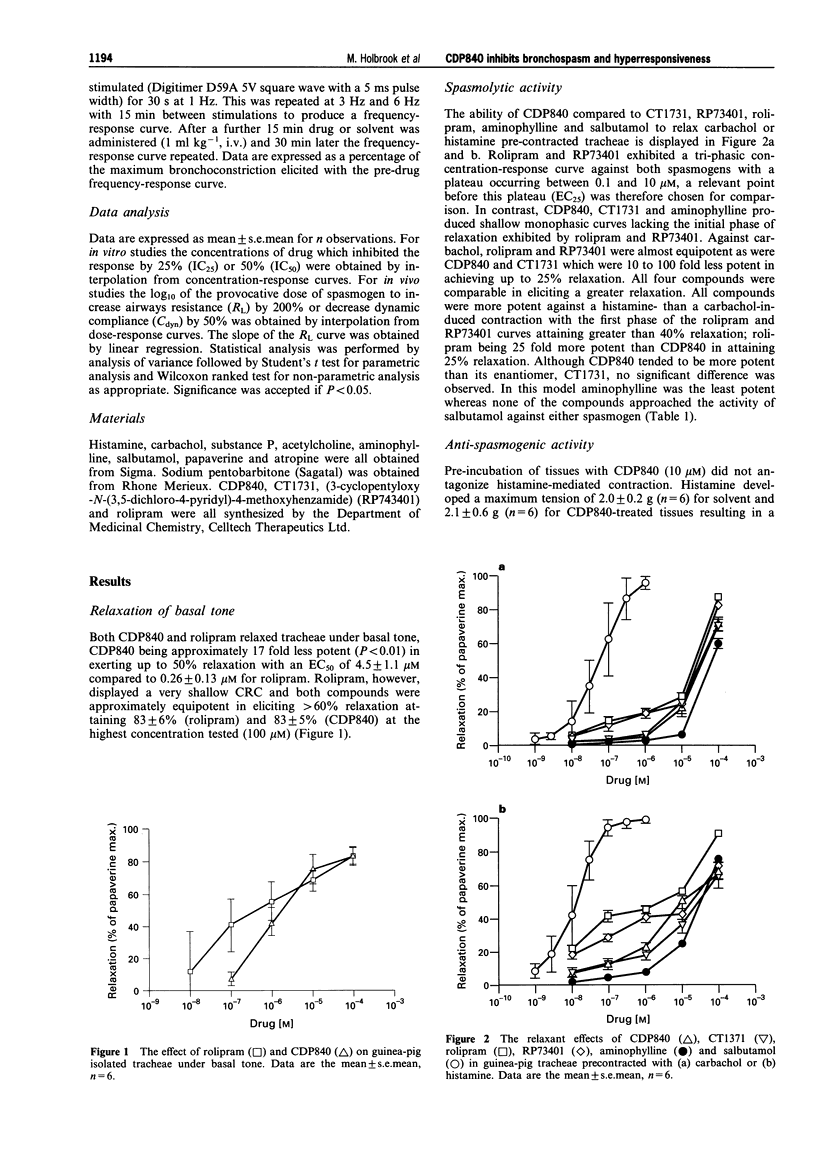
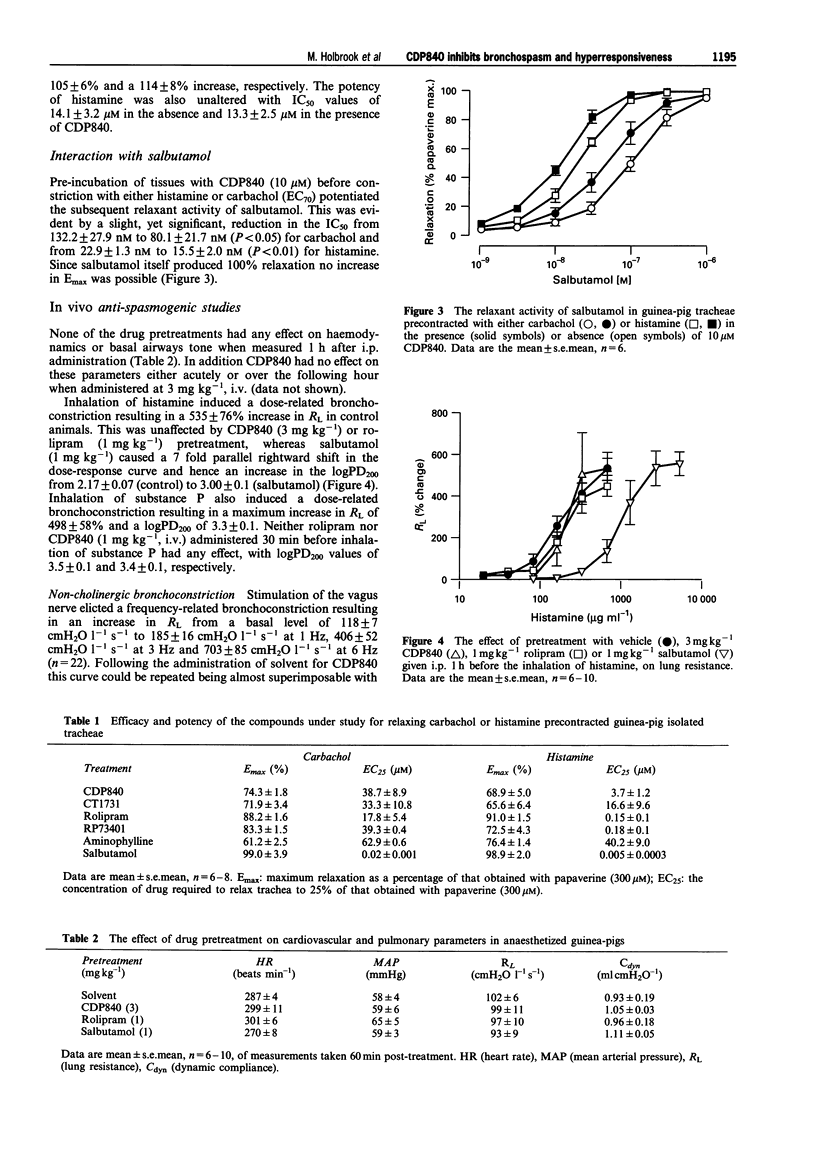
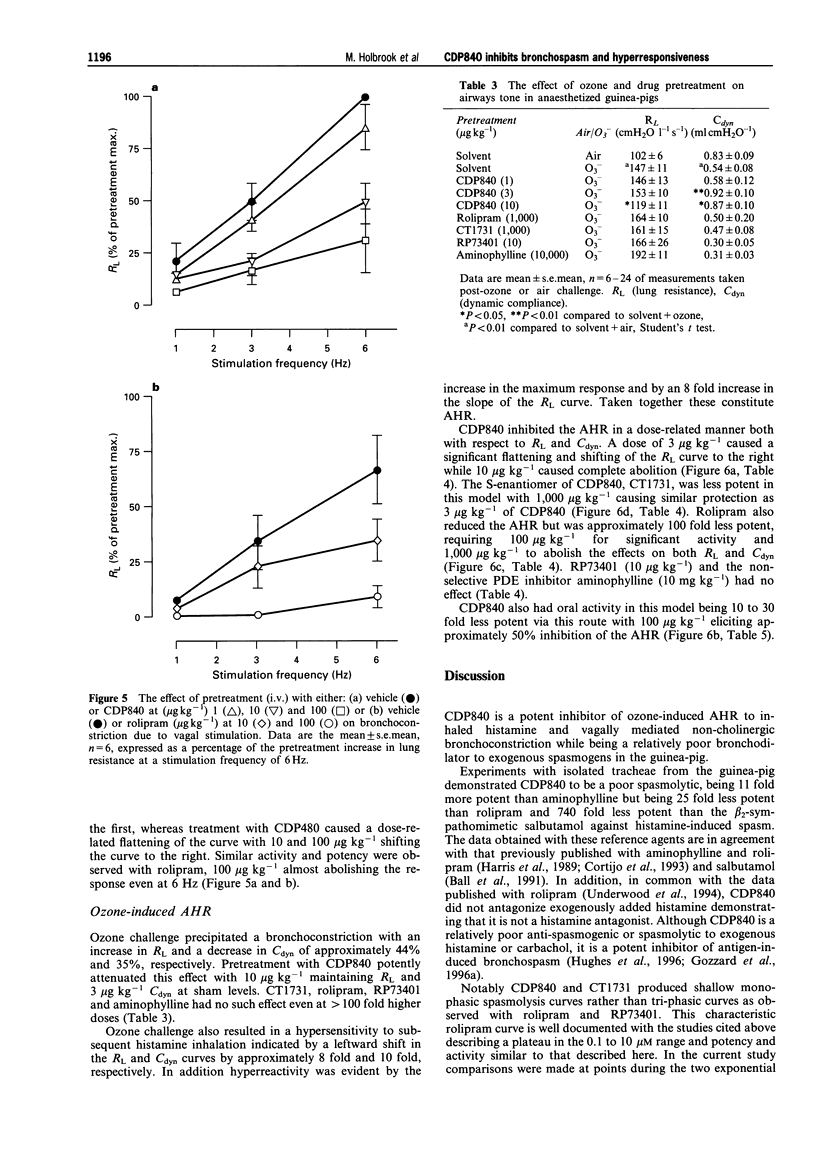
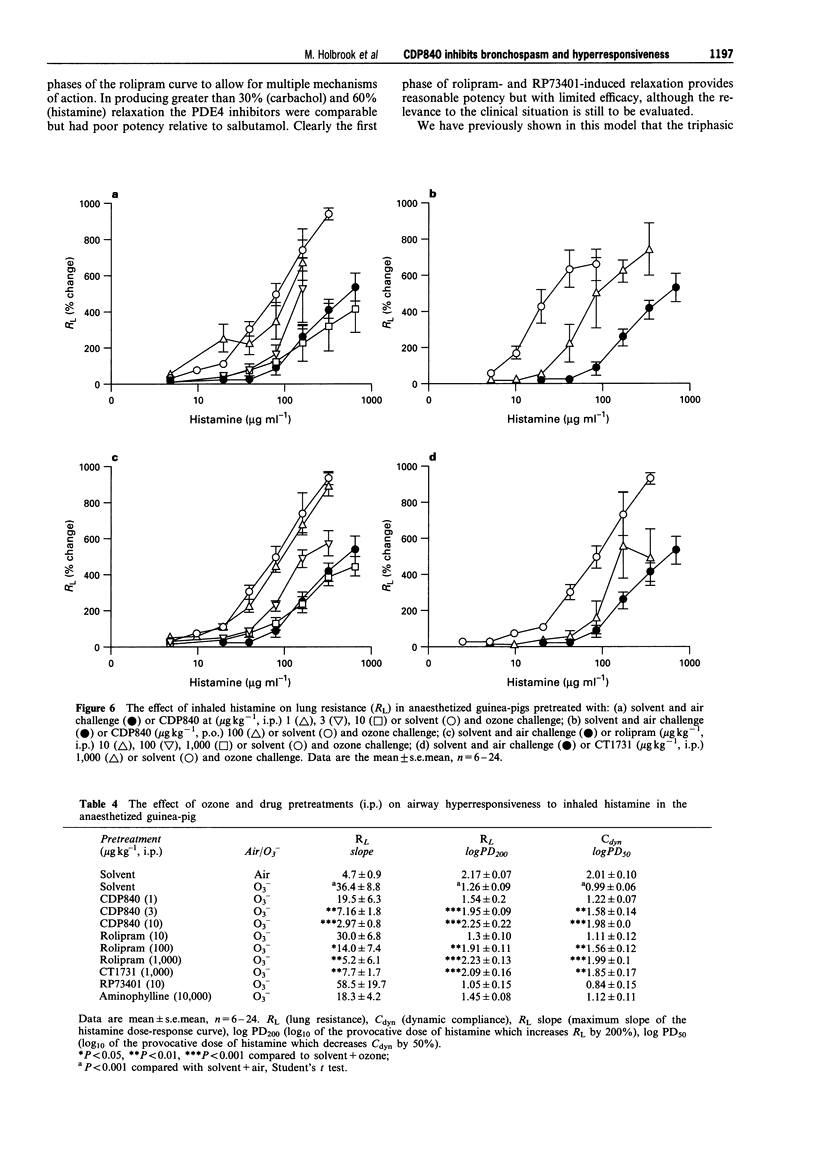
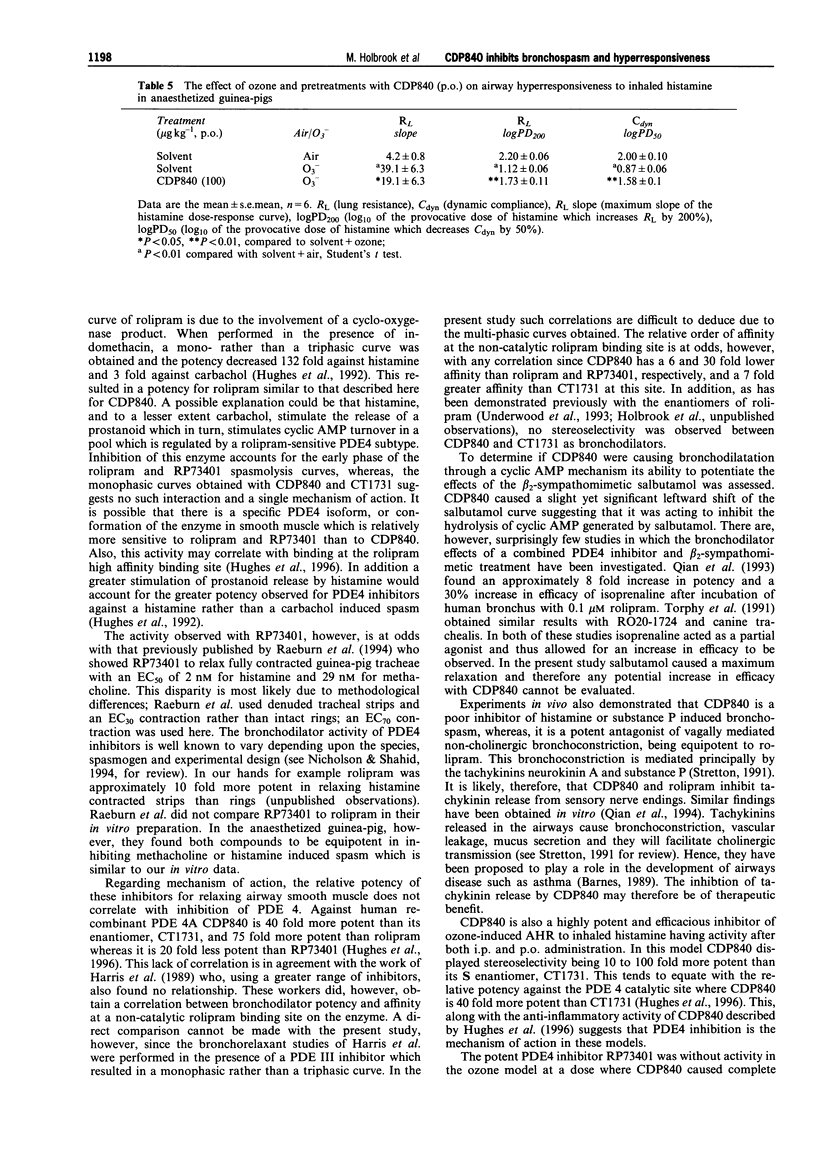
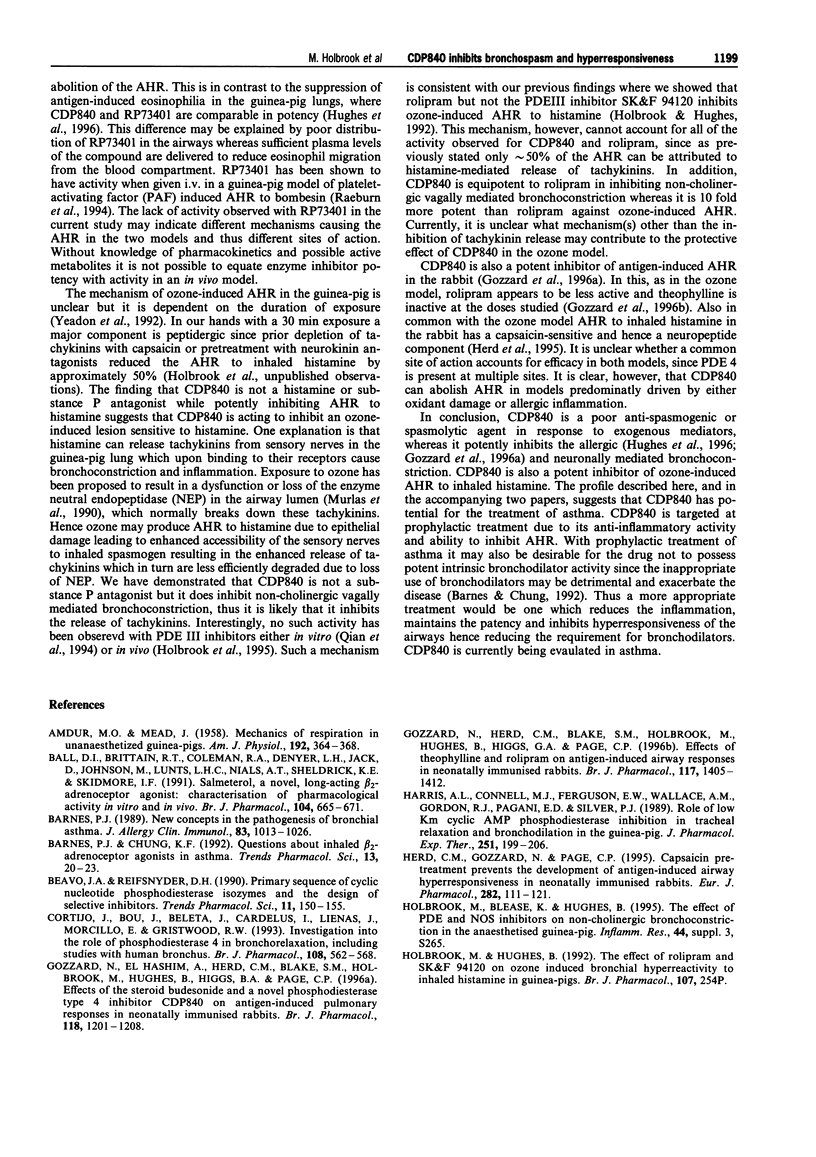
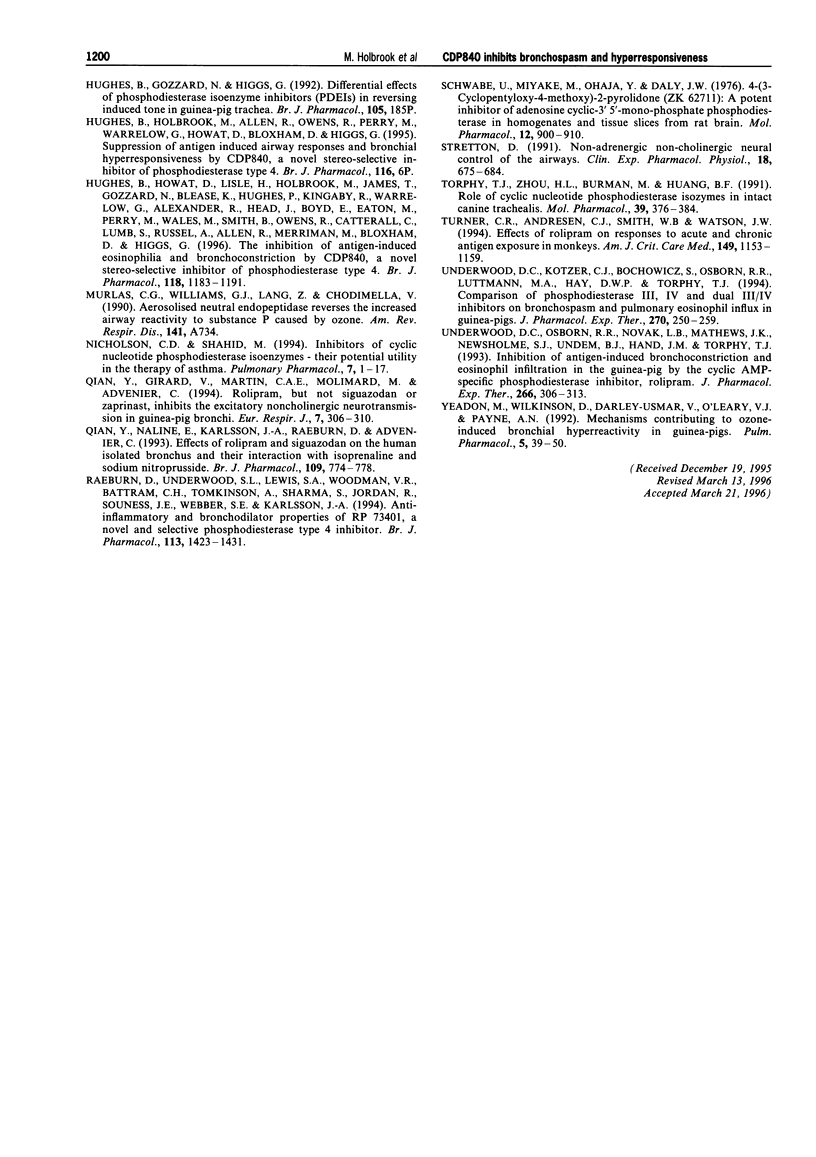
Selected References
These references are in PubMed. This may not be the complete list of references from this article.
- AMDUR M. O., MEAD J. Mechanics of respiration in unanesthetized guinea pigs. Am J Physiol. 1958 Feb;192(2):364–368. doi: 10.1152/ajplegacy.1958.192.2.364. [DOI] [PubMed] [Google Scholar]
- Ball D. I., Brittain R. T., Coleman R. A., Denyer L. H., Jack D., Johnson M., Lunts L. H., Nials A. T., Sheldrick K. E., Skidmore I. F. Salmeterol, a novel, long-acting beta 2-adrenoceptor agonist: characterization of pharmacological activity in vitro and in vivo. Br J Pharmacol. 1991 Nov;104(3):665–671. doi: 10.1111/j.1476-5381.1991.tb12486.x. [DOI] [PMC free article] [PubMed] [Google Scholar]
- Barnes P. J., Chung K. F. Questions about inhaled beta 2-adrenoceptor agonists in asthma. Trends Pharmacol Sci. 1992 Jan;13(1):20–23. doi: 10.1016/0165-6147(92)90011-t. [DOI] [PubMed] [Google Scholar]
- Barnes P. J. New concepts in the pathogenesis of bronchial hyperresponsiveness and asthma. J Allergy Clin Immunol. 1989 Jun;83(6):1013–1026. doi: 10.1016/0091-6749(89)90441-7. [DOI] [PubMed] [Google Scholar]
- Beavo J. A., Reifsnyder D. H. Primary sequence of cyclic nucleotide phosphodiesterase isozymes and the design of selective inhibitors. Trends Pharmacol Sci. 1990 Apr;11(4):150–155. doi: 10.1016/0165-6147(90)90066-H. [DOI] [PubMed] [Google Scholar]
- Cortijo J., Bou J., Beleta J., Cardelús I., Llenas J., Morcillo E., Gristwood R. W. Investigation into the role of phosphodiesterase IV in bronchorelaxation, including studies with human bronchus. Br J Pharmacol. 1993 Feb;108(2):562–568. doi: 10.1111/j.1476-5381.1993.tb12841.x. [DOI] [PMC free article] [PubMed] [Google Scholar]
- Gozzard N., Herd C. M., Blake S. M., Holbrook M., Hughes B., Higgs G. A., Page C. P. Effects of theophylline and rolipram on antigen-induced airway responses in neonatally immunized rabbits. Br J Pharmacol. 1996 Apr;117(7):1405–1412. doi: 10.1111/j.1476-5381.1996.tb15299.x. [DOI] [PMC free article] [PubMed] [Google Scholar]
- Gozzard N., el-Hashim A., Herd C. M., Blake S. M., Holbrook M., Hughes B., Higgs G. A., Page C. P. Effect of the glucocorticosteroid budesonide and a novel phosphodiesterase type 4 inhibitor CDP840 on antigen-induced airway responses in neonatally immunised rabbits. Br J Pharmacol. 1996 Jul;118(5):1201–1208. doi: 10.1111/j.1476-5381.1996.tb15524.x. [DOI] [PMC free article] [PubMed] [Google Scholar]
- Harris A. L., Connell M. J., Ferguson E. W., Wallace A. M., Gordon R. J., Pagani E. D., Silver P. J. Role of low Km cyclic AMP phosphodiesterase inhibition in tracheal relaxation and bronchodilation in the guinea pig. J Pharmacol Exp Ther. 1989 Oct;251(1):199–206. [PubMed] [Google Scholar]
- Herd C. M., Gozzard N., Page C. P. Capsaicin pre-treatment prevents the development of antigen-induced airway hyperresponsiveness in neonatally immunised rabbits. Eur J Pharmacol. 1995 Aug 25;282(1-3):111–119. doi: 10.1016/0014-2999(95)00291-r. [DOI] [PubMed] [Google Scholar]
- Hughes B., Howat D., Lisle H., Holbrook M., James T., Gozzard N., Blease K., Hughes P., Kingaby R., Warrellow G. The inhibition of antigen-induced eosinophilia and bronchoconstriction by CDP840, a novel stereo-selective inhibitor of phosphodiesterase type 4. Br J Pharmacol. 1996 Jul;118(5):1183–1191. doi: 10.1111/j.1476-5381.1996.tb15522.x. [DOI] [PMC free article] [PubMed] [Google Scholar]
- Nicholson C. D., Shahid M. Inhibitors of cyclic nucleotide phosphodiesterase isoenzymes--their potential utility in the therapy of asthma. Pulm Pharmacol. 1994 Feb;7(1):1–17. doi: 10.1006/pulp.1994.1001. [DOI] [PubMed] [Google Scholar]
- Qian Y., Girard V., Martin C. A., Molimard M., Advenier C. Rolipram, but not siguazodan or zaprinast, inhibits the excitatory noncholinergic neurotransmission in guinea-pig bronchi. Eur Respir J. 1994 Feb;7(2):306–310. doi: 10.1183/09031936.94.07020306. [DOI] [PubMed] [Google Scholar]
- Qian Y., Naline E., Karlsson J. A., Raeburn D., Advenier C. Effects of rolipram and siguazodan on the human isolated bronchus and their interaction with isoprenaline and sodium nitroprusside. Br J Pharmacol. 1993 Jul;109(3):774–778. doi: 10.1111/j.1476-5381.1993.tb13641.x. [DOI] [PMC free article] [PubMed] [Google Scholar]
- Raeburn D., Underwood S. L., Lewis S. A., Woodman V. R., Battram C. H., Tomkinson A., Sharma S., Jordan R., Souness J. E., Webber S. E. Anti-inflammatory and bronchodilator properties of RP 73401, a novel and selective phosphodiesterase type IV inhibitor. Br J Pharmacol. 1994 Dec;113(4):1423–1431. doi: 10.1111/j.1476-5381.1994.tb17156.x. [DOI] [PMC free article] [PubMed] [Google Scholar]
- Schwabe U., Miyake M., Ohga Y., Daly J. W. 4-(3-Cyclopentyloxy-4-methoxyphenyl)-2-pyrrolidone (ZK 62711): a potent inhibitor of adenosine cyclic 3',5'-monophosphate phosphodiesterases in homogenates and tissue slices from rat brain. Mol Pharmacol. 1976 Nov;12(6):900–910. [PubMed] [Google Scholar]
- Stretton D. Non-adrenergic, non-cholinergic neural control of the airways. Clin Exp Pharmacol Physiol. 1991 Oct;18(10):675–684. doi: 10.1111/j.1440-1681.1991.tb01380.x. [DOI] [PubMed] [Google Scholar]
- Torphy T. J., Zhou H. L., Burman M., Huang L. B. Role of cyclic nucleotide phosphodiesterase isozymes in intact canine trachealis. Mol Pharmacol. 1991 Mar;39(3):376–384. [PubMed] [Google Scholar]
- Turner C. R., Andresen C. J., Smith W. B., Watson J. W. Effects of rolipram on responses to acute and chronic antigen exposure in monkeys. Am J Respir Crit Care Med. 1994 May;149(5):1153–1159. doi: 10.1164/ajrccm.149.5.8173755. [DOI] [PubMed] [Google Scholar]
- Underwood D. C., Kotzer C. J., Bochnowicz S., Osborn R. R., Luttmann M. A., Hay D. W., Torphy T. J. Comparison of phosphodiesterase III, IV and dual III/IV inhibitors on bronchospasm and pulmonary eosinophil influx in guinea pigs. J Pharmacol Exp Ther. 1994 Jul;270(1):250–259. [PubMed] [Google Scholar]
- Underwood D. C., Osborn R. R., Novak L. B., Matthews J. K., Newsholme S. J., Undem B. J., Hand J. M., Torphy T. J. Inhibition of antigen-induced bronchoconstriction and eosinophil infiltration in the guinea pig by the cyclic AMP-specific phosphodiesterase inhibitor, rolipram. J Pharmacol Exp Ther. 1993 Jul;266(1):306–313. [PubMed] [Google Scholar]
- Yeadon M., Wilkinson D., Darley-Usmar V., O'Leary V. J., Payne A. N. Mechanisms contributing to ozone-induced bronchial hyperreactivity in guinea-pigs. Pulm Pharmacol. 1992;5(1):39–50. doi: 10.1016/0952-0600(92)90016-a. [DOI] [PubMed] [Google Scholar]


